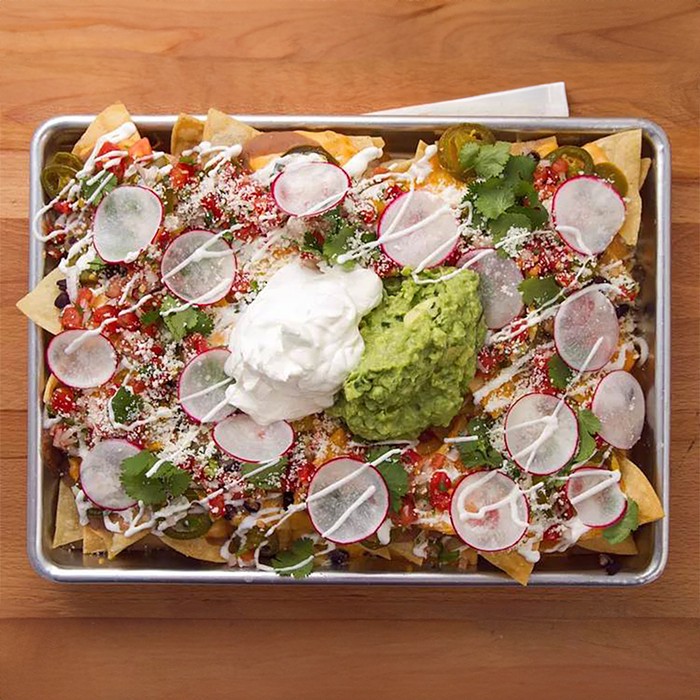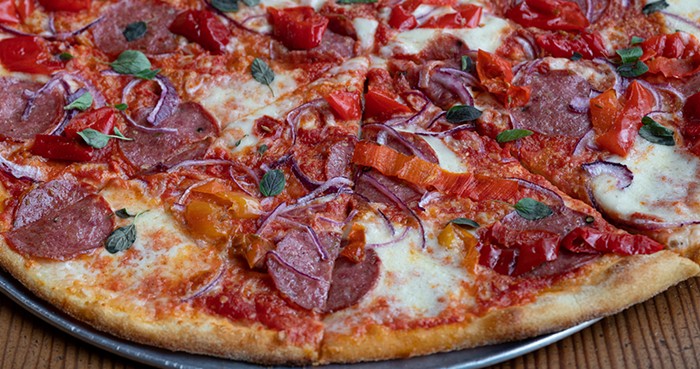For nearly 30 years, the corner of Martin Luther King Jr. Way and Cherry Street in the Central District was synonymous with one thing: catfish. It was here that Woody and Rosemary Jackson opened their restaurant Catfish Corner in 1985, serving the fried catfish and gumbo that Woody ate as a boy in Louisiana.
Eventually, Woody and Rosie retired and sold the restaurant. In 2014, Catfish Corner closed. (Thankfully, their grandson Terrell has resurrected the family business in the South Seattle neighborhood of Brighton.) For months, the building, once a bustling institution of the Central District, sat empty and forlorn.
Finally, last September, the storied corner was reborn as Fat's Chicken and Waffles, a Southern restaurant from Marcus Lalario, who also owns Li'l Woody's Burgers on Capitol Hill and in Ballard, as well as the Capitol Hill sports bar 95 Slide. (Lalario also owns a clothing store, Alive & Well; a screen-printing company, Midnight Supply Co.; and an artist management company, Goodrich and Gold. This spring, he's opening another restaurant, Ciudad, in Georgetown.) Despite his many successful ventures, Lalario says the thought of opening a new business in an iconic location in the quickly changing, historically black neighborhood of the Central District was intimidating.
"I was well aware of the history of this neighborhood," says Lalario, who lives nearby. "When I was younger, I used to come to Catfish Corner all the time. But I look at restaurants at a cultural level, how I can be part of the neighborhood. I knew Fat's would be perfect for this spot."
Chef Patrick Dours, another Louisiana native, is in charge of the menu and kitchen at Fat's. He's turning out solid versions of the food he's been eating and cooking his whole life—fried chicken, shrimp and grits, collard greens, mac and cheese, and, yes, catfish. This is comfort food, through and through, executed with real confidence, care, and consistency.
While the waffles in the restaurant's signature dish are regrettably thin and flaccid, the fried chicken ($14 for a breast or two legs) is good and moist, with a satisfyingly crunchy exterior—thick, salty, with plenty of spices like black and cayenne pepper. Dours's spice blend also has a surprisingly generous amount of celery seed, which gives the heavy, meaty dish a welcome vegetal note.
The red beans and rice ($12) are terrific. The bowl arrives fragrant and steaming, begging you to lean in and take a few deep whiffs before digging in. The beans are stewed with smoked ham hock and pickled pork, creating a rich broth with an uncommon depth of flavor—tangy, earthy, smoky, and spicy. I topped mine with a few breaded and perfectly fried oysters ($5 extra—you can also add fried chicken, shrimp, or catfish), which added both a briny crunch and creaminess.
Entrées of chicken, shrimp, oysters, and catfish, all fried but never greasy, are available as sandwiches or plates, the latter of which are served with two side dishes. And while the fried-chicken sandwich ($14) comes with a delightful twist—a thick schmear of pimento cheese—you'd be wise to order your protein on a plate so you can sample some of Dours's best work: sausage gravy and collard greens.
Plain rice is transformed into something luxurious by this fantastic gravy—creamy and viscous, piquant, with big crumbles of andouille sausage. Dours cooks his roux thoroughly, so there's a solid backbone of flavor and none of the tragic raw flour taste commonly encountered in lesser gravies. You'll want to eat it on its own, by the spoonful. He also takes hours to simmer collard greens into silky submission, imbuing them with a vinegary tang and the smokiness of cured pork. You'll pick up the little bowl and guzzle the warm juices as they dribble down your chin.
Dours is a talented chef, though the current menu of mostly Southern classics doesn't give him much room to play around. When he does, the results are impressive. Weeks later, I'm still thinking about the fried green tomato and shrimp salad ($12). The textures of the crispy slices of tomato and plump poached shrimp played off each other nicely. The whole dish, which includes pungent pickled red onions and spicy rémoulade dressing, was unapologetically vinegary and brightly acidic. While the rest of Fat's menu uses richness to give comfort, Dours shows that sour notes can be just as satisfying. Lalario says his chef will be launching a gumbo night soon, as well as occasional daily specials. I'm excited to see what he comes up with.
A few months after opening, Fat's added a weekend brunch with dishes like biscuits and gravy and eggs Benedict with Crystal hot sauce hollandaise—all of them priced at just $8. Neighbors took notice. Lalario says brunch service "has been bananas." Just last week, Fat's debuted its weekday lunch menu, which will be sure to draw in teenagers from nearby Garfield High. Parents should know that Fat's kid's menu is a great deal—$5 gets you one meat and one side. (And those menus, which are meant to be drawn and colored on, come with a side of crayons.)
Small children can happily gnaw on a drumstick for 20 minutes while their parents leisurely sip house-made Hurricanes that are heavy on rum, bright red with grenadine, but pleasantly light on the sugar. It's all part of the relaxed, easygoing vibe that's cultivated and overseen by general manager Erika White, who has a way of making everyone feel at home.
By day, Fat's is awash in light, and you can't help but notice the gorgeous walnut benches and tables handmade by local artist Nick Yoshihara, or the patterned mural painted by another Seattle artist, Jesse Brown, that occupies an entire wall. Soon your eye gravitates to the airy plants dangling from macramé plant hangers or the dream catcher mounted over the bar.
At night, vintage lamps on each table and the neon sign in the window ("Southern Catfish," it reads, a relic from the old days) bathe the room in glowing orange, yellow, and purple light. Soul and R&B music plays on a sound system that's better than what you'll find at most bars and clubs in town, and old movies are projected onto a big screen.
You'll come to Fat's for the food, but you'll stay for the warm and familiar feeling it gives you. Lalario says he wanted to create "a place that feels like it's been here for a while already." He's succeeded. But day-to-day, that vision is executed by Dours and White, and Lalario says Fat's is very much their restaurant, too.
"Erika went to Garfield, and she played basketball there," he says. "This is her neighborhood way more than it is mine. You have to trust other people's vision, too."
By doing so, Lalario has done something significant. He's replaced a Central District institution with something entirely new, but filled it with the people and energy that have always been there.



















